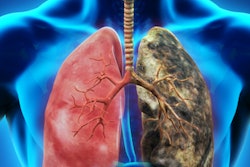
A large study from a real-world CT lung cancer screening program in China failed to find a benefit to screening high-risk individuals, according to a study published in JAMA Network Open online November 3. But the results may have been affected by compliance and how the screening protocol was set up.
In the six-year study with follow-up through March 2020, the lung cancer detection rate of 0.35% among high-risk individuals was similar to the rate of those who did not have low-dose CT (LDCT) screening, at 0.38%. The difference was not statistically significant.
Lung cancer screening with low-dose CT has already proven effective through large-scale studies in the U.S. and Europe. In the U.S., the National Lung Screening Trial (NLST) in 2011 found that screening with CT produced a 20% mortality reduction compared with screening with chest x-ray, while results from the Dutch-Belgian Randomized Lung Cancer Screening (NELSON) study released earlier this year found that screening produced a mortality reduction of 24% for men and 33% for women, compared with no screening.
In China, the lung cancer mortality rate has risen by 465% in the last 30 years, and the survival rate for lung cancer is only 19.7%. To address the problem, the Chinese government in 2012 launched the Cancer Screening Program in Urban China (CanSPUC), which directs screening to those at high risk for cancer.
Lung cancer is one of six tumor types that have been targeted for effort in urban areas through CanSPUC, along with cancers of the breast, esophagus, stomach, colon, and liver. Through CanSPUC, eligible residents can get screened for free. The current study was conducted to analyze the effectiveness of that program and to compare it to those in the U.S. and Europe.
China's program uses a risk score system to determine who should get low-dose CT. In the current study, out of 282,377 people (between the ages of 40 and 74) considered for lung cancer screening in eight cities, 55,428 met the risk criteria. And of the 55,428, only 22,260 went on to get low-dose CT, a compliance rate of 40%, according to a team led by Lan-Wie Guo, PhD, of the Affiliated Cancer Hospital of Zhengzhou University/Henan Cancer Hospital, in Zhengzhou, China, and colleagues reported.
The researchers used a screening protocol in which participants were screened once with a 16-slice CT scanner. Unlike the NLST and NELSON studies, participants in the CanSPUC program did not receive subsequent screening rounds.
At the six-year follow-up point, the researchers found 78 cases of cancer in the group that was screened, compared with 125 cases in the group that was not screened. Getting screened produced an odds ratio of 0.93 that cancer would be detected, with a p-value of 0.61.
| Detection of lung cancer with CT screening in China | ||
| No screening | CT screening | |
| No. of patients screened | 33,168 | 22,260 |
| No. of cancers detected | 125 | 78 |
| Cancer detection rate | 0.38%* | 0.35%* |
The researchers attributed the lack of statistical significance in the program to its low participation rate for high-risk individuals of 40%, which compares unfavorably with the 95% participation rate in the NLST.
"Given the relatively low participation rate in LDCT screening, most lung cancer cases were missed during the program, which substantially reduced the effectiveness of screening," the authors wrote.
Women were more likely to take part than men, even though men were more likely to test positive. Former smokers and those with a family history of cancer also had higher participation rates.
The authors also noted that compliance with CT lung screening has been an ongoing problem with real-world programs. Although the NLST study had a 95% participation rate, the use of low-dose CT (LDCT) in practice has been very low. A 2015 study in the U.S. found a compliance rate of 3.9%, while a 2017 trial found compliance had improved somewhat, to 14.1%.
"The poor compliance with LDCT screening appears to be a common problem in real-world LDCT screening programs involving large sample populations," the authors wrote.
In the China study, compliance was not explicitly studied, but researchers believe a range of factors could have influenced participation rates, including the following, with variations depending on the city involved:
- Time from recruitment to screening was too long
- Distance to screening location
- Poor awareness of lung cancer screening
Furthermore, the authors postulated that the study protocol of only scanning individuals once could have reduced its effectiveness.
"[T]he low detection rate in our study might be explained by patients only being screened once, whereas early lung cancer sometimes requires serial scans to be clinically apparent," they noted.
Guo et al concluded by noting that improvements could be made to improve the effectiveness of low-dose CT lung cancer screening. They suggested that data from their study be helpful for optimizing risk assessment and designing new risk-adapted screening strategies across the population.
"Our results suggest that public awareness campaigns are necessary to improve the participation rate of lung cancer screening in the future," the authors wrote.




















